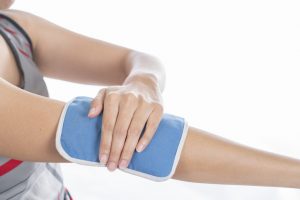Injuries are a massive set back in sport and fitness. If not identified early on, they can result in further damage or longer recovery times. Here’s my guide on how to prevent injuries during exercise. I include the most common types of injury, techniques for rehabilitation, and essential tips for how to prevent injuries from occurring.
Why Do We Get Injured?
Before we look at how to prevent injuries, it’s important to know why they happen. There are many reasons why we can become injured. Lack of warm-up and poor technique are two common reasons. However, stress can also increase the risk of injury in sport and exercise. Alongside this, inappropriate clothing and footwear can contribute to this risk. We will look at each of these in detail.

Most Common Injuries
Before you learn how to prevent injuries, it’s useful to be mindful of the common ways to get injured. So, I’ve listed some of the most common injuries that can occur in a gym environment:
- Sprained ankle.
- Knee injuries/knee pain
- Shoulder injuries (read more in my post about rotator cuff injuries)
- Muscle strains/sprains
- Shin splints
- Tendonitis
- Lower back pain
Now we know what to look out for, let’s look at how to prevent injuries from occurring.
How to Prevent Injuries During Exercise
1. Leave Stress At The Door
When it comes to how to prevent injuries, we rarely think about life stress. However, when we are stressed, we’re thinking about many things at once. If we aren’t focused on our workout, we can quite easily slip into poor technique, a leading cause of injury. Rushing exercise also poses a risk.
So it is essential to leave your stress behind when we come into the gym. Try some simple mindfulness techniques if you’re stressed before exercising. Focus on your breathing, or practice mind-muscle connection while you work out. These simple practices will help reduce the risk of injury.
2. Don’t Rush Your Warm-up
This is one of the most overlooked principles of how to prevent injuries. It’s easy to rush through a warm-up or skip it altogether. However, this vastly increases the risk of injury. Our bodies need to warm up gradually. This increases blood supply to our muscles, which makes them more durable when exercising. Increasing our overall body temperature helps reduce the chances for muscle or tendon injuries. An increase in body temperature also contributes to faster muscle contraction and relaxation as well as increasing nerve stimulation (Safran et al., 1989). So, before you begin your workout, start yourself off with some gentle cardio – maybe a light jog or skip. After this, incorporate some dynamic stretching on the lower limbs and upper body.
3. Wear Appropriate Attire
For how to prevent injuries in the lower body, the right footwear is crucial. Having supportive trainers is essential in maintaining stability in your ankles and knees. Ensuring the arches of your feet are well supported is also a must. Barnes and Smith (1994) suggest that the shoe can be thought of as a powerful tool that is responsible for the biomechanics of the lower limb and if used effectively can reduce the risk of injury.
Shoes aren’t the only thing we need to think of. Clothing is just as important. You need to find something comfortable to workout in. Regarding how to prevent injuries, anything that takes your mind off the exercise you’re doing can also increase risk. Not only do your workout clothes need to be comfortable but also suitable. Ensuring clothing doesn’t get in the way, snag, or prevent you from checking your form, is essential.
4. Incorporate Strength Training
When thinking about how to prevent injuries, this is often overlooked. Cardio is great for cardiovascular fitness but doesn’t build much in the way of strength. The stronger we are, the less we are susceptible to injuries. Studies have shown that a stronger muscle can absorb more energy before failure than a weaker muscle (Garrett, 1996).

One thing to keep in mind when it comes to how to prevent injury is overuse of the same muscles. This can be especially risky in strength training. How to prevent injuries occurring through overtraining is simple. Just alternate the muscle groups you work each session.
5. Listen to Your Body and Rest
Listening to your body and resting is crucial. If you feel a twinge or any pain when you work out, don’t ignore it – stop. This could be your body’s way of telling you how to prevent injuries. If you push through pain, you’re more likely to worsen the damage and cause a chronic injury. One way to nip this in the bud is to pay attention to muscle soreness post workout. If your soreness lasts more than 48 hours, the chances are you need to ease of the training a little.
How To Prevent Injuries Becoming Chronic
Sometimes, injuries are unavoidable. If you do get injured, it’s important not to get frustrated and allow the body the time it needs to heal. Continuing to train on injuries will only make them worse, and they could end up chronic. This is a bad situation to be in as it may prevent you from training altogether. So, now we have covered how to prevent injuries, let’s look at how to rehabilitate them.
RICE
If you do sustain an injury, use the steps in RICE. This is an acronym that helps us remember what to do in the initial stages of an injury. When used appropriately RICE can improve recovery time and reduce discomfort. It is said that this type of treatment is best management practice in the first 24-48 hours following acute soft tissue damage. These steps will help to reduce swelling and minimise further bleeding (Jarvinen et al., 2005).
- Rest
Resting the affected limb is essential. It is recommended that for the first few days, rest is very useful in the treatment of a soft tissue injury. This is useful for short periods, as this allows scar tissue to form.
- Ice
Ice is used to reduce swelling in an affected area and causes blood vessel constriction. The reduction in swelling can then in turn help with range of movement. It’s always good to be mindful if you have any circulation issues or sensation problems and to be careful when using ice. Keep the ice wrapped in a tea towel (do not apply directly to the skin) and apply it to the area for approx. 15-20 minutes at a time.

- Compression
Compression can help with any further swelling that may occur as a result of the inflammatory process. A simple thing such as a Tubigrip around the affected site will help to reduce the swelling and compress the area.
- Elevation
Elevation again will help with swelling by increasing venous return, or the rate of blood flow back to the heart. Always try to elevate the limb above the heart to encourage this. For example, if you have an ankle injury, raise it above the heart using a couple of pillows while lying down.
Conclusion
We’ve looked at the common types of injury in the gym and why they occur. We next covered how to prevent injuries. Finally, we looked at what to do to ensure your injury heals as soon as possible. You’re now well equipped for a safe workout! Need a fitness programme now you know how to exercise safely? Click here to read our guide on how to choose a workout plan.
